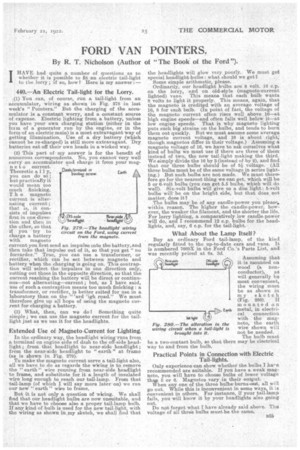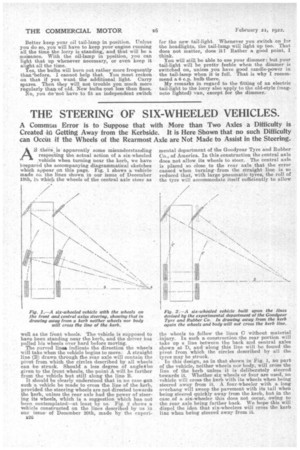FORD VAN POINTERS.
Page 25

Page 26

If you've noticed an error in this article please click here to report it so we can fix it.
By R. T. Nicholson (Author of "The Book of the Ford ").
IHAVE had quite a number of questions as to whether it is possible to fit an electric tail-light to the lorry ; if so, how ? Here is my answer :— 440.—An Electric Tail-light for the Lorry.
,(1) You can, of course' run a tail-light from an accumulator, wiring as shown in Fig. 278 in last week's "Pointers." But the charging of the accumulator is a constant worry, and a constant source of expense. Electric lighting from a battery, unless you have your own charging station (either in the foim of a generator run by the engine, or in the form.of an electric main) is a most extravagant way of getting illumination. Use of a dry battery (which cannot be re-charged) is still more extravagant. Dry batteries eat off their own heads in a wicked way.
(2) This part ofmy answer is for the benefit of numerous correspondents. No, you eannot very well carry an accumulator and charge it from your magneto current. Theoretic a 11 y, you can do so ; but practically it would mean too much finicking. T h e magneto current is alternating current; that is, it consists of impulses first in one direction and then in the other, so that if you try to charge a battery with magneto current you first send an impulse into the battery, and then take that impulse out of it, so that you get " no forrarder." True, you can use a transformer, or rectifier, which can be set between magneto and battery when the charging is going on. This contraption will select the impulses in one direction only, cutting out those in the opposite direction, so that the current reaching the battery will be direct or continuous—not alternating—current; but, as I have said, use of such a contraption means too much finicking: a transformer, or rectifier, is better suited for use in a laboratory than on the." 'ard 'igh road." We must therefore give up all hope of using the magneto current for charging a battery.
(3) What, then, Can we do ? Something quite simple; we can use:the magneto current for the taillight just as we use it for the headlights.
Daalaterelieal crr bindillg screw.
Off-aide Naar-side
headlight, headlieht Fig. 279.—The headlight wiring circuit on the Ford, using current from the magneto. Earth
Extended Use of Magneto-Current for Lighting.
In the ordinary way, the headlight wiring runs from a terminal on engine side of dash to the off-side headlight; from that headlight to near-side headlight ; from the near-side headlight to " earth " at frame (as is shown in Fig. 279). To make the magneto current serve a tail-light also, all we have to do as regards the wiring is to remove the " earth " wire running from near-side headlight to frame, and eubstitute for it a length of insulated wire long enough to reach our tail-lamp. From that tail-lamp (of which I will say more later on) we run our new "earth" " wire to frame.
But it is not only a question of wiring. We shall find that our headlight bulbs are now unsuitable, and that we have to choose also a proper tail-lamp bulb. If any kind of bulb is used for the new tail-light, with the wiring as shown in.my sketch, we shall find that _ the headlights will glow very poorly. We must get special headlight bulbs : what should we get? Some simple arithmetic, please.
Ordinarily, our headlight la-albs are 8 volt. 16 c.p. on the lorry, and on old-style (magneto-current lighted) vans. This means that each lull) wants 8 volts to light it properly. This means, again, that the magneto is credited with an average voltage of 16, 8 for each bulb. (In point of fact, the voltage of the magneto current often rises well above 16—at high engine speeds—and often falls well below it—at low engine speeds. That is why magneto lighting puts such big strains on the bulbs, and tends to burn them out quickly. But we must assume some average magneto current voltage, and 16 is about right; though magnetos differ in their voltage.) Assuming a magneto voltage of 16, WC have to ask ourselves what kind of bulb a we must use if there are three of them instead of two, the new tail-light making the third. We simply divide the 16 by 3 (instead of by 2), and find that our three bulbs should be of 51 voltage. (All three bulbs must be of the same voltage in series lighting.) But such bulbs are not. made. We must therefore go for the nearest thing we can get, which will be 5 or 6-volt bulbs (you can get 5.5 bulbs, which will do well). Six-volt bulbs will give us a dim light : 5-volt bulbs will' be on the bright side, but that does not matter, does it ?
The bulbs may be of any candle-power you please,. within reason. The higher the .candle-power, however, the weaker the filament, and the shorter the life. For lorry lighting, a comparatively low candle-power will do, and I recommend 12 c.p. bulbs for the headlights, and, say, 6 c.p. for the tail-light. •
What About the Lamp Itself?
. Buy an ordinary Ford tail-lamp, of the kind regularly fitted to the up-to-date cars and vans. It is numbered 7669X in the Ford Co.'s Parts List, and was recently priced at 8s. 3d. Assuming that it is mounted on wood (a nonconductor), as will generally be most convenient, the wiring must be as shown in my sketch. (Fig. 280). If mounted on
1111Ewth metal, in dead-
cal cal
10yd 414 withthe magneto, the earth wire shown will not be needed.
Fig. 280.—The alteration in the wiring circuit when a tail-light is brought into it. The bulb must be a two-contact bulb, so that there may be electrical way to and from the bulb.
Practical Points in Connection with Electric Tail -lights.
Only experience can show whether the bulbs I ,ha•-e recommended are suitable. If you have a weak magneto, you will have to choose bulbs of lower voltage thak 5 or 6. Magnetos vary in their output. When any one of the three bulbrelaurns,out, all will go out. While this is inconvenient in some ways, it is convenient in others. For instance, if your tail-lamp fails, you will know it by your headlights also going out.
Do not forget what I have already said above, The voltage of all three bulbs must-be the same.
Better keep your oil tail-lamp in position. Unless you do so, you will have to keep your engine running all the time the lorry is standing, and that will be a ..nuisance. With the oil-lamp in position, you can light that up whenever necessary, or even keep it alight all the time.
Yes, the 'bulbs will burn out rather more frequently than4before. I cannot help that. You must reckon on that if you want the additional light. Carry spares. Then they will not trouble you much more regularly than of old. New bulbs cost less than fines. No, you do'not have to fit an independent switch for the new tail-light. Whenever you switch on for the headlights, the tail-lamp will light up too. That does not matter, does it? Rather a good point, I think.
You will still be able to use your dimmer: but. your tail-light will be pretty feeble when the dimmer is switched on, unless you have good candle-power in the tail-lamp when it is full. That is why I recommend a 6 c.p. bulb there. My remarks in regard to the fitting of an electric tail-light to the lorry also apply to the old-style (magneto lighted) van, except for the dimmer.






























